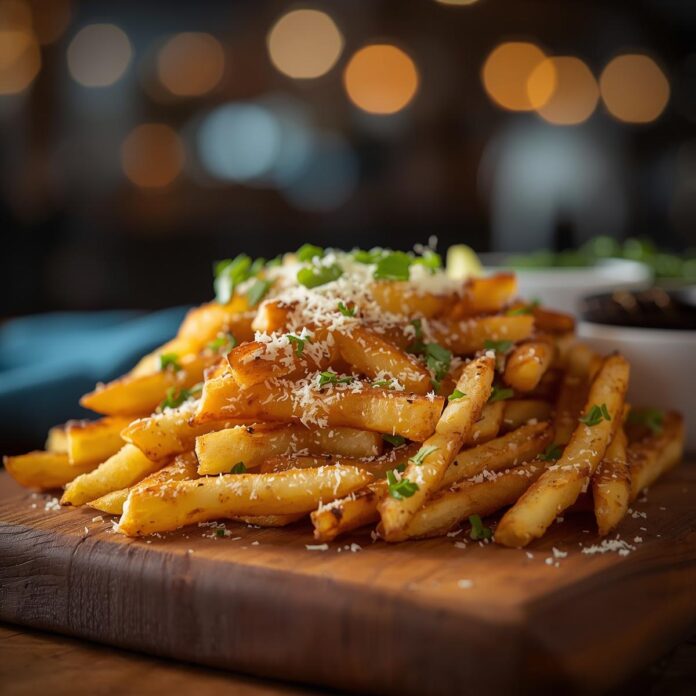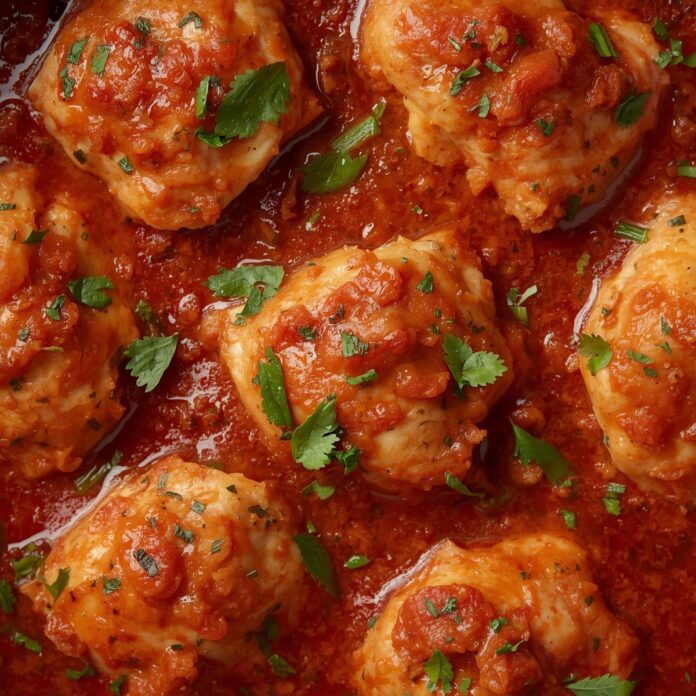Few dishes capture the harmony of contrast quite like Mango Chicken Stir Fry—a vibrant dance between sweet and savory, heat and freshness, simplicity and sophistication. The first bite is a revelation: tender strips of chicken, seared until golden and glossy, coated in a tangy-sweet glaze of ripe mango, ginger, garlic, and soy. There’s a flash of tropical brightness followed by the grounding warmth of umami and spice, a balance so seamless it feels both refreshing and indulgent. It is a dish that speaks fluently in flavor—the fruit’s sunlit sweetness countered by the deep, caramelized savor of stir-fried chicken and vegetables.

At its heart, Mango Chicken Stir Fry represents what modern cooking does best: bridging cultures, ingredients, and textures into something entirely new yet instinctively comforting. Stir-frying itself is an ancient art—one that dates back thousands of years to Chinese kitchens, where quick, high-heat cooking was both practical and precise. It preserves texture, color, and nutrients while coaxing maximum flavor from minimal ingredients. Over time, this method traveled across Asia and beyond, absorbing local influences and ingredients. When the bright, fragrant mango entered this technique—likely through Southeast Asian or Polynesian adaptations—it transformed the stir fry from savory simplicity to something layered, colorful, and cosmopolitan.
The beauty of Mango Chicken Stir Fry lies in its balance of opposites. The mango, rich in natural sugars and aromatic compounds, caramelizes lightly in the wok, coating each piece of chicken with a glossy glaze that’s neither cloying nor sour. The sauce is a conversation between fruit and spice: the sweetness of mango balanced by soy sauce’s saltiness, the acidity of lime juice or rice vinegar, and the gentle heat of chili or ginger. The chicken, when cooked correctly, remains juicy inside with a slightly crisp edge—absorbing the sauce like a sponge, while crisp-tender vegetables add color, crunch, and contrast.
This dish also showcases the philosophy of freshness. Where heavy sauces or prolonged cooking might dull flavor, stir-frying celebrates immediacy. Each element—be it the snap of a snow pea, the perfume of garlic, or the golden sheen of mango puree—retains its individuality, even as it contributes to the harmony of the whole. The result is a dish that feels alive: bright in color, vibrant in taste, and layered in texture.
To truly appreciate Mango Chicken Stir Fry, it helps to understand the role mango plays in the culinary world. In tropical cuisines, mango has long been more than just a fruit; it’s a seasoning, a sauce, a tenderizer, and even a pickled condiment. Its versatility is born of its complex chemistry—combining sweetness, acidity, and an aromatic profile that deepens as the fruit ripens. When pureed or diced, mango provides not just flavor but body, giving sauces natural thickness without relying on cream or starch. It also acts as a bridge between spicy, salty, and sour ingredients—softening edges while amplifying depth. This makes it the ideal partner for lean proteins like chicken, whose mild flavor becomes a canvas for the mango’s vibrancy.
The chicken itself plays a crucial role in this symphony. While beef or shrimp stir-fries rely on assertive flavor and texture, chicken offers a neutrality that lets the mango’s perfume shine through. The key is preparation: thin, uniform slices of boneless chicken breast or thigh, marinated briefly for tenderness and umami depth, then seared in a hot wok until lightly caramelized. The sear is essential—it’s the moment where flavor builds, when proteins brown through the Maillard reaction, creating savory notes that will later mingle with the sweetness of mango. This marriage of savory depth and tropical fruit is what elevates the dish from novelty to refinement.
Equally important are the supporting characters: the vegetables and aromatics. Bell peppers, red onions, and snow peas bring color and crispness, each adding its own dimension. Garlic and ginger provide warmth, grounding the fruit’s brightness with their pungent bite. A hint of chili or red pepper flakes adds heat—not to dominate, but to highlight. Every ingredient plays a role in maintaining equilibrium: sweet and savory, soft and crisp, vibrant yet comforting.
Moreover, this dish embodies the essence of balance through simplicity. Unlike Western fruit sauces that can be overly sweet or syrupy, the best Mango Chicken Stir Fry relies on restraint. It uses fruit to enhance, not overpower; soy sauce to deepen, not darken; and acid to sharpen without souring. Every component exists in service of the whole. When executed with care, the result is both refreshing and comforting—a dish that feels like a summer afternoon captured in flavor, yet hearty enough to satisfy in any season.
In the chapters that follow, we’ll explore everything necessary to perfect this dish—from the selection of mangoes and chicken cuts to the science of stir-frying, sauce construction, and timing. You’ll learn why heat control is the soul of wok cooking, why the sequence of ingredients determines flavor layering, and how to achieve restaurant-level texture in your own kitchen. We’ll dive into variations—spicy, coconut-infused, or citrus-forward—and examine how to adapt the recipe to different diets without losing its essence.
By the end of this guide, you’ll not only know how to make Mango Chicken Stir Fry—you’ll understand it. You’ll recognize the signs of perfect wok temperature by sight and sound, know how to balance sweetness and salt by instinct, and appreciate how this dish, though seemingly simple, represents centuries of culinary refinement and cultural exchange. Most importantly, you’ll discover that what makes this recipe truly special isn’t just the mango, or the chicken, or the sauce—it’s the harmony between them, the dialogue between nature’s sweetness and the cook’s precision.
Mango Chicken Stir Fry is more than a meal—it’s a celebration of balance, a testament to what happens when tropical abundance meets culinary discipline. It’s the kind of dish that invites joy from the very first sizzle to the final, fragrant bite.
Detailed Instructions
Understanding the Core Components
A great Mango Chicken Stir Fry begins with understanding the harmony of its parts. Each ingredient contributes something essential — flavor, texture, aroma, or color — and the balance among them defines the dish. The chicken provides body and umami depth; the mango delivers sweetness and fragrance; the aromatics and vegetables bring vibrancy and contrast. The sauce unites it all, coating each piece in a glossy, flavorful glaze that binds the elements together.
Before heat meets wok, precision begins at the prep table. The success of a stir fry depends less on complicated techniques and more on preparation, timing, and control. Everything must be measured, sliced, and ready — because once the wok is hot, every second counts.
Selecting and Preparing Ingredients
1. Choosing the Right Mango
The soul of this dish lies in the mango, so selection is critical. The ideal mango should be ripe enough to yield sweetness and perfume, yet firm enough to hold its shape when heated.
Recommended varieties:
-
Ataulfo (Honey or Champagne Mango): Creamy, buttery, and less fibrous, with a rich golden color and floral sweetness.
-
Kent or Keitt Mangoes: Slightly tangier, with a balance of sweetness and acidity ideal for sauces.
-
Avoid overly ripe mangoes: They become mushy when cooked and can overpower the dish with sweetness.
Preparation:
-
Peel the mango using a sharp paring knife or peeler.
-
Cut the flesh away from the pit in large slabs.
-
Dice one half into small cubes (to toss in the stir fry).
-
Puree the remaining mango flesh in a blender until smooth. This puree will form the foundation of the sauce.
Why this matters:
Using both pureed and diced mango layers flavor — the puree thickens and sweetens the sauce, while the diced mango adds bursts of fruit within the savory glaze.
2. Preparing the Chicken
The chicken is the canvas that absorbs the sauce’s complexity. Both breast and thigh meat work well, but each offers a distinct result:
-
Breast: Lean, tender, cooks quickly; ideal for a lighter texture.
-
Thigh: Juicier and more forgiving; better for deeper flavor and moisture retention.
Preparation:
-
Trim away excess fat or sinew.
-
Slice the chicken thinly across the grain into uniform strips about ¼-inch thick.
-
Uniform thickness ensures even cooking.
-
-
Place in a bowl and prepare a quick marinade:
-
1 tablespoon soy sauce
-
1 teaspoon cornstarch
-
½ teaspoon sesame oil
-
1 teaspoon rice wine or dry sherry (optional, for depth)
-
Pinch of salt and pepper
-
Let the chicken marinate for 10–15 minutes while preparing the remaining ingredients.
Why marinate?
This step isn’t just about flavor — it’s about texture. The combination of soy, cornstarch, and oil forms a thin protective layer around the meat, known in Chinese technique as velveting. It prevents the chicken from drying out and promotes a smooth, silky finish once cooked.
3. Preparing the Vegetables and Aromatics
Balance is key. The vegetables should add freshness and texture without overshadowing the mango or chicken.
Suggested Vegetables:
-
1 red bell pepper, thinly sliced
-
1 yellow bell pepper, thinly sliced
-
1 small red onion, cut into petals or wedges
-
1 cup snow peas or sugar snap peas, trimmed
-
1 small carrot, julienned (optional, for color and crunch)
Aromatics:
-
3 cloves garlic, minced
-
1-inch piece of fresh ginger, finely grated
-
1–2 red chilies or ½ teaspoon red pepper flakes (optional, for heat)
Prepare all vegetables and aromatics before heating the wok. In stir-frying, the window between raw and perfect is measured in seconds. Having ingredients ready is essential for rhythm and precision.
Crafting the Mango Stir Fry Sauce
The sauce is where science and intuition meet. It binds sweet, salty, and tangy notes into a unified whole — a glaze that should cling, not pool; enrich, not mask.
Base Sauce Ingredients:
-
½ cup fresh mango puree
-
2 tablespoons soy sauce
-
1 tablespoon oyster sauce (optional, for umami depth)
-
1 tablespoon rice vinegar or lime juice
-
1 tablespoon honey or brown sugar (adjust to mango sweetness)
-
½ teaspoon chili sauce or sriracha (optional)
-
1 teaspoon cornstarch dissolved in 2 tablespoons water (for thickening)
Preparation:
Whisk all ingredients together in a small bowl until smooth. Taste and adjust — it should be slightly sweet, bright with acidity, and just savory enough to balance the fruit.
Culinary insight:
The cornstarch slurry activates only when heated, transforming the liquid into a glossy, clingy glaze. Soy and oyster sauce contribute glutamates (umami compounds), which round out the mango’s fruitiness and give the sauce dimension.
The Stir-Fry Technique
The stir-fry is both art and performance — an act of precision that relies on heat, motion, and timing. To master it, think in stages: aromatics, protein, vegetables, sauce, and finish.
1. Preparing the Wok
Use a carbon steel wok if possible; it heats rapidly and responds instantly to temperature changes. If unavailable, a large stainless-steel skillet works.
-
Heat the wok over high heat until a thin wisp of smoke appears.
-
Add 1–2 tablespoons of oil (preferably peanut, canola, or grapeseed). Swirl to coat.
Pro Tip:
A well-heated wok prevents sticking and ensures even searing. Stir-frying in a cold pan results in steaming instead of searing, dulling both color and flavor.
2. Cooking the Chicken
-
Once the oil shimmers, add the marinated chicken in a single layer.
-
Let it sear undisturbed for 30–45 seconds to develop color.
-
Stir-fry for another 2–3 minutes until the chicken is 80% cooked.
-
Remove the chicken and set aside on a plate.
Why remove it?
Chicken cooks quickly and can toughen if left in the wok too long. Removing it prevents overcooking and allows better control when adding the sauce later.
3. Stir-Frying the Vegetables and Aromatics
-
Add another tablespoon of oil if needed.
-
Add garlic, ginger, and chili; stir-fry for 10–15 seconds until fragrant — no longer, or they’ll burn.
-
Add onions and bell peppers; toss briskly for 1 minute.
-
Add snow peas and carrots; stir another minute until vegetables are crisp-tender.
Technique note:
Vegetables in stir-fry should retain life — bright in color, tender yet crisp. Overcooked vegetables bleed moisture and flatten the dish’s texture.
4. Combining the Chicken and Sauce
-
Return the chicken (and any juices) to the wok.
-
Stir the prepared sauce, then pour it over the contents.
-
Stir constantly to coat every piece evenly.
-
Add diced mango during the final 30 seconds of cooking.
As the sauce thickens, it will transform from translucent to glossy, clinging beautifully to each ingredient. The diced mango will warm and soften slightly, releasing aroma without disintegrating.
Sensory cue:
When you hear the wok shift from a wet sizzle to a dry crackle and the sauce looks shiny, the dish is done.
Finishing Touches
Remove the wok from heat. Taste and adjust seasoning — a squeeze of lime for brightness, a touch of soy for salt, or a drizzle of sesame oil for depth.
Optional garnishes:
-
Toasted sesame seeds for nuttiness
-
Chopped cilantro or scallions for freshness
-
Crushed peanuts or cashews for crunch
Serve immediately over jasmine rice, coconut rice, or noodles. The dish should arrive at the table steaming, fragrant, and vivid — the kind of meal that delights eyes first and then the palate.
Professional Tips and Troubleshooting
1. Timing and Temperature:
If the wok cools, the stir fry steams instead of sears. Always cook in small batches.
2. Texture Control:
If the sauce thickens too much, add a splash of water or broth to loosen it.
3. Sauce Overpowering the Mango:
Reduce sugar or honey if your mangoes are naturally sweet. The sauce should accentuate, not dominate.
4. Chicken Toughness:
Marinate properly and avoid overcooking. Chicken should be added back only for the final minute.
5. Vegetarian or Vegan Adaptation:
Substitute tofu or tempeh for chicken, and replace oyster sauce with soy or mushroom sauce.
Serving, Pairing, and Presentation
Presentation:
Mango Chicken Stir Fry shines when served family-style in a shallow bowl or platter. The bright mango glaze should glisten against the colorful vegetables.
Pairing ideas:
-
Side: Steamed jasmine rice, coconut-infused basmati, or thin rice noodles.
-
Drink: Tropical fruit iced tea, or sparkling water with lime.
Culinary note:
The subtle acidity of wine or lime cuts through the dish’s sweetness, refreshing the palate between bites.
Mango Chicken Stir Fry
Few dishes capture the harmony of contrast quite like Mango Chicken Stir Fry—a vibrant dance between sweet and savory, heat and freshness, simplicity and sophistication. The first bite is a revelation: tender strips of chicken, seared until golden and glossy, coated in a tangy-sweet glaze of ripe mango, ginger, garlic, and soy. There’s a flash of tropical brightness followed by the grounding warmth of umami and spice, a balance so seamless it feels both refreshing and indulgent. It is a dish that speaks fluently in flavor—the fruit’s sunlit sweetness countered by the deep, caramelized savor of stir-fried chicken and vegetables.
Ingredients
- For the Stir Fry:
- 1 lb (450 g) boneless, skinless chicken breast or thighs — thinly sliced
- 1 large ripe (but firm) mango — peeled, pitted, and diced
- 1 red bell pepper — thinly sliced
- 1 small onion — sliced
- 2 cloves garlic — minced
- 1 tablespoon fresh ginger — minced
- 2 tablespoons vegetable oil (divided)
- Salt and black pepper — to taste
- 2 green onions — sliced (for garnish)
- Sesame seeds (optional, for garnish)
- For the Sauce:
- 3 tablespoons soy sauce (or tamari for gluten-free)
- 2 tablespoons sweet chili sauce
- 1 tablespoon rice vinegar (or lime juice)
- 1 tablespoon honey (or brown sugar)
- 1 teaspoon sesame oil
- ½ teaspoon cornstarch (optional, for thicker sauce)
- 1 tablespoon water (to mix with cornstarch, if using)
Instructions
1. Prepare the Sauce
In a small bowl, whisk together soy sauce, sweet chili sauce, rice vinegar, honey, sesame oil, and (if using) cornstarch slurry. Set aside.
2. Cook the Chicken
- Heat 1 tablespoon oil in a large wok or skillet over medium-high heat.
- Add the sliced chicken, season lightly with salt and pepper, and stir-fry for 4–5 minutes until golden and cooked through.
- Remove chicken from the pan and set aside.
3. Stir-Fry the Vegetables
- In the same pan, add the remaining 1 tablespoon oil.
- Add onion, bell pepper, garlic, and ginger. Stir-fry for 2–3 minutes, until fragrant and just tender.
- Add the mango and cook another 1–2 minutes, stirring gently so the mango keeps its shape.
4. Combine Everything
- Return the cooked chicken to the pan.
- Pour in the prepared sauce and toss to coat evenly.
- Cook for 1–2 minutes, allowing the sauce to thicken slightly and coat the chicken and veggies.
5. Serve
- Remove from heat and top with sliced green onions and sesame seeds.
- Serve hot over steamed jasmine rice, brown rice, or noodles.
Notes
- Choose a firm, ripe mango — overly soft ones will break down too much when cooking.
- For spice, add a pinch of red pepper flakes or a drizzle of sriracha.
- This recipe works great with shrimp or tofu instead of chicken.



